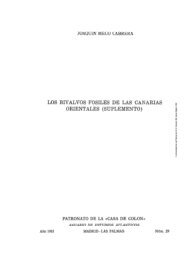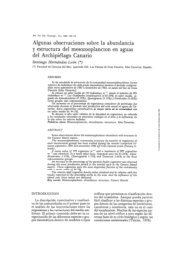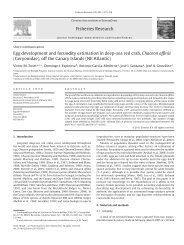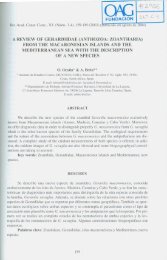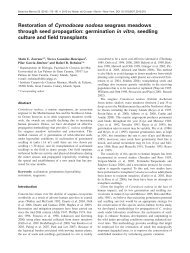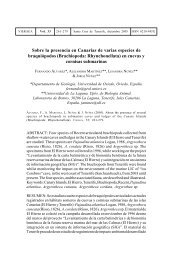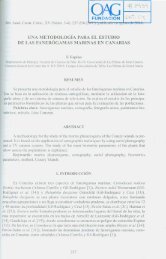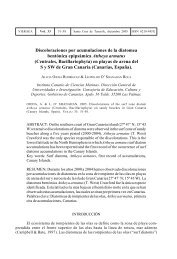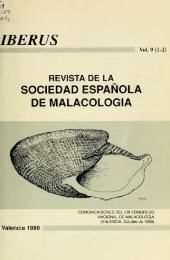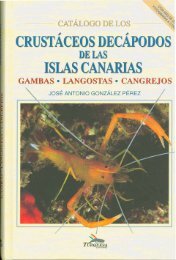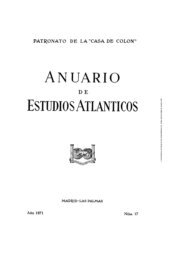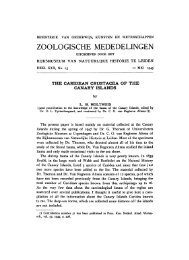of the madeira and selvagens archipelagos - redmic
of the madeira and selvagens archipelagos - redmic
of the madeira and selvagens archipelagos - redmic
Create successful ePaper yourself
Turn your PDF publications into a flip-book with our unique Google optimized e-Paper software.
páticas. Por outro lado, existem dois géneros monoespecíficos<br />
e endémicos: Alophozia e Nobregaea.<br />
À escala regional, é importante ter em conta os taxa infraespecíficos,<br />
uma vez que a sua exclusão reduz o número<br />
de taxa endémicos. Este é o caso de Plagiomnium undulatum<br />
(Hedw.) T.J.Kop. var. madeirense T.J.Kop. & Sérgio e de<br />
Jubula hutchinsiae (Hook.) Dumort. var. integrifolia Lind.<br />
6. Relação e similaridade com outros arquipélagos<br />
da Macaronésia<br />
Uma análise comparativa das nove famílias mais diversas<br />
dos arquipélagos da Macaronésia é apresentada nas<br />
Figuras 5 e 6. Apesar do nível de conhecimento actual em<br />
briologia não ser o mesmo para os diferentes arquipélagos,<br />
é, ainda assim, possível observar uma congruência no que<br />
diz respeito às famílias com maior número de taxa, tanto<br />
para as hepáticas (Lejeuneaceae, Ricciaceae e Jungermanniaceae)<br />
como para os musgos (Pottiaceae, Bryaceae<br />
e Brachy<strong>the</strong>ciaceae).<br />
A reduzida presença ou até ausência de taxa de musgos<br />
pleurocárpicos pode indicar que as espécies e subespécies<br />
persistentes são menos diversificadas nestes grupos de<br />
ilhas. Apesar disso, as famílias Brachyteciaceae, Fissidentaceae<br />
e Bryaceae estão representadas por um gr<strong>and</strong>e número<br />
de espécies e subespécies em todos os arquipélagos,<br />
e a família Hypnaceae está bem representada nos Açores.<br />
Com o acréscimo das condições xéricas para os arquipélagos<br />
mais a sul, é evidente a presença de um maior número<br />
de taxa de Ricciaceae e Pottiaceae nas ilhas Canárias e em<br />
Cabo Verde. Por outro lado, existe um maior número de taxa<br />
de Jungermanniaceae nos Açores e na Madeira, já que estas<br />
hepáticas têm pouca capacidade de suportar condições de<br />
secura. É de realçar a gr<strong>and</strong>e percentagem de Sphagnaceae<br />
e de Dicranaceae no arquipélago dos Açores (Figs. 5 e 6). À<br />
escala regional, o arquipélago com a flora mais rica é o da<br />
Madeira, seguido pelo das ilhas Canárias, pelo dos Açores,<br />
e por último, pelo de Cabo Verde (Quadro 2). De notar que<br />
a diferença no número de espécies e subespécies entre os<br />
vários grupos de ilhas estudados, vari<strong>and</strong>o de 24 taxa em<br />
Cabo Verde até 360 taxa na Madeira, reflecte apenas parcialmente<br />
a diferença real na diversidade de espécies entre<br />
os arquipélagos.<br />
133<br />
<strong>and</strong> Radula. Alophosia <strong>and</strong> Nobregaea, on <strong>the</strong> o<strong>the</strong>r h<strong>and</strong>,<br />
are two endemic monotypic genera.<br />
In general, on a regional scale, it is <strong>of</strong> interest to consider<br />
<strong>the</strong> infra -specific categories, as <strong>the</strong>ir exclusion reduces<br />
<strong>the</strong> number <strong>of</strong> endemic <strong>and</strong> characteristic taxa. This is <strong>the</strong><br />
case <strong>of</strong> Plagiomnium undulatum (Hedw.) T.J. Kop. var. madeirense<br />
T.J. Kop. & Sérgio <strong>and</strong> Jubula hutchinsiae (Hook.)<br />
Dumort. var. integrifolia Lind.<br />
6. Relationship <strong>and</strong> similarity with o<strong>the</strong>r Macaronesian<br />
<strong>archipelagos</strong><br />
A comparative analysis <strong>of</strong> <strong>the</strong> nine more diversified families<br />
in each <strong>of</strong> <strong>the</strong> Macaronesian <strong>archipelagos</strong> is shown<br />
in Figures 5 <strong>and</strong> 6. A preliminary taxonomic pattern can be<br />
inferred from this analysis, despite <strong>the</strong> lack <strong>of</strong> congruence<br />
<strong>of</strong> <strong>the</strong> status <strong>of</strong> bryological knowledge between <strong>the</strong> differente<br />
<strong>archipelagos</strong>. In general, <strong>the</strong> families with higher number<br />
<strong>of</strong> taxa were <strong>the</strong> same in <strong>the</strong> four <strong>archipelagos</strong>, both for<br />
liverworts (Lejeuneaceae, Ricciaceae <strong>and</strong> Jungermanniaceae),<br />
<strong>and</strong> mosses (Pottiaceae, Bryaceae <strong>and</strong> Brachy<strong>the</strong>ciaceae).<br />
The lack <strong>of</strong>, or low presence <strong>of</strong> pleurocarpous moss taxa<br />
may indicate that families <strong>of</strong> perennial species are less diversified<br />
in all isl<strong>and</strong> groups. Never<strong>the</strong>less, Brachyteciaceae<br />
are well represented in all <strong>archipelagos</strong> but Hypnaceae are<br />
more diverse in <strong>the</strong> Azores. Fissidentaceae are well represented<br />
in all regions as well as Bryaceae. Under increasing<br />
xeric conditions, towards <strong>the</strong> Sou<strong>the</strong>rn <strong>archipelagos</strong> <strong>of</strong> <strong>the</strong><br />
Canary Isl<strong>and</strong>s <strong>and</strong> Cape Verde, <strong>the</strong> increase in <strong>the</strong> number<br />
<strong>of</strong> taxa <strong>of</strong> <strong>the</strong> Ricciaceae <strong>and</strong> Pottiaceae is evident. By contrast,<br />
<strong>the</strong> larger number <strong>of</strong> taxa <strong>of</strong> <strong>the</strong> Jungermanniaceae<br />
at <strong>the</strong> Azores <strong>and</strong> Madeira <strong>archipelagos</strong> was expected, as<br />
<strong>the</strong>se liverworts have a reduced drought -stress capacity. It<br />
is important to highlight <strong>the</strong> large percentage <strong>of</strong> taxa belonging<br />
to <strong>the</strong> Sphagnaceae <strong>and</strong> Dicranaceae in <strong>the</strong> Azores<br />
(Figs. 5 <strong>and</strong> 6). At a regional level, <strong>the</strong> archipelago with <strong>the</strong><br />
richest Flora is Madeira, followed by <strong>the</strong> Canary Isl<strong>and</strong>s,<br />
Azores <strong>and</strong> Cape Verde (Table 2). The large difference in <strong>the</strong><br />
numbers <strong>of</strong> species among <strong>the</strong> various isl<strong>and</strong> groups (ranging<br />
from 24 up to 360, between Cape Verde <strong>and</strong> Madeira)<br />
reflects only partly <strong>the</strong> real difference in species’ diversity.<br />
Quadro 2. | Table 2.<br />
Diversidade de briófitos nos arquipélagos da Macaronésia (Ma – Madeira e Selvagens; Ac – Açores; Ca – Ilhas<br />
Canárias; CV – Cabo Verde).<br />
Diversity <strong>of</strong> bryophytes in <strong>the</strong> Macaronesian <strong>archipelagos</strong> (Ma – Madeira <strong>and</strong> Selvagens; Ac – Azores; Ca – Canary<br />
Isl<strong>and</strong>s; CV – Cape Verde).<br />
Ma Ac Ca CV Total<br />
Musgos | Mosses 333 283 323 116 551<br />
Hepáticas/antocerotas | Liverworts/hornworts 179 155 139 37 241<br />
Total 512 438 462 153 792



